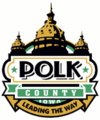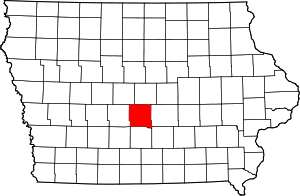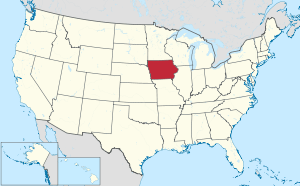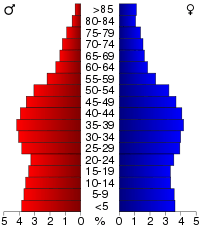Polk County, Iowa
Polk County is a county in the U.S. state of Iowa. As of the 2010 census, the population was 430,640,[1] making it Iowa's most populous county, hosting over 14% of the state's residents. The county seat is Des Moines,[2] which is also the capital city of Iowa.
Polk County | |
|---|---|
Polk County Courthouse | |
 Seal | |
 Location within the U.S. state of Iowa | |
 Iowa's location within the U.S. | |
| Coordinates: 41°41′06″N 93°34′13″W | |
| Country | |
| State | |
| Founded | January 13, 1846 |
| Named for | James K. Polk |
| Seat | Des Moines |
| Largest city | Des Moines |
| Area | |
| • Total | 592 sq mi (1,530 km2) |
| • Land | 574 sq mi (1,490 km2) |
| • Water | 18 sq mi (50 km2) 3.0% |
| Population (2010) | |
| • Total | 430,640 |
| • Estimate (2019) | 490,161 |
| • Density | 730/sq mi (280/km2) |
| Time zone | UTC−6 (Central) |
| • Summer (DST) | UTC−5 (CDT) |
| Congressional district | 3rd |
Polk County is included in the Des Moines–West Des Moines, IA Metropolitan Statistical Area.[3]
History
On January 13, 1846, the legislative body of the Iowa Territory authorized creation of twelve counties in the Territory,[4] with general descriptions of their boundaries. On January 17 they further enacted a resolution setting the effective date of the county government for Jasper and Polk Counties as March 1, 1846.[5] Polk County's name referred to United States President James K. Polk, who served from 1845 to 1849.
The first courthouse, a two-story structure, was built in Des Moines in 1846. Rapid settlement and commercial growth in the county soon rendered this building insufficient, so construction of a larger building was initiated in 1858. Due to construction delays and the onset of the Civil War, the structure was not completed until 1866. The present courthouse was erected in 1906, and in 1962 it was extensively renovated and enlarged.[6]
Geography
According to the US Census Bureau, the county has a total area of 592 square miles (1,530 km2), of which 574 square miles (1,490 km2) is land and 18 square miles (47 km2) (3.0%) is water.[7] The county is bisected by the Des Moines River.
Major highways
Communities
Cities
Census-designated place
Unincorporated communities
Demographics
| Historical population | |||
|---|---|---|---|
| Census | Pop. | %± | |
| 1850 | 4,513 | — | |
| 1860 | 11,625 | 157.6% | |
| 1870 | 27,857 | 139.6% | |
| 1880 | 42,395 | 52.2% | |
| 1890 | 65,410 | 54.3% | |
| 1900 | 82,624 | 26.3% | |
| 1910 | 110,438 | 33.7% | |
| 1920 | 154,029 | 39.5% | |
| 1930 | 172,837 | 12.2% | |
| 1940 | 195,835 | 13.3% | |
| 1950 | 226,010 | 15.4% | |
| 1960 | 266,315 | 17.8% | |
| 1970 | 286,101 | 7.4% | |
| 1980 | 303,170 | 6.0% | |
| 1990 | 327,140 | 7.9% | |
| 2000 | 374,601 | 14.5% | |
| 2010 | 430,640 | 15.0% | |
| Est. 2019 | 490,161 | [8] | 13.8% |
| U.S. Decennial Census[9] 1790–1960[10] 1900–1990[11] 1990–2000[12] 2010–2019[1] | |||
2010 census
The 2010 census recorded a population of 430,640 in the county, with a population density of 756.371/sq mi (292.037/km2). There were 182,262 housing units, of which 170,197 were occupied.[13]
2000 census

As of the census[14] of 2000, there were 374,601 people, 149,112 households, and 96,624 families in the county. The population density was 658 people per square mile (254/km²). There were 156,447 housing units at an average density of 275 per square mile (106/km²). The racial makeup of the county was 88.34% White, 4.84% Black or African American, 0.27% Native American, 2.63% Asian, 0.06% Pacific Islander, 2.22% from other races, and 1.66% from two or more races. 4.40% of the population were Hispanic or Latino of any race. 25.9% were of German, 10.6% Irish, 9.0% English and 8.4% American ancestry.
Of the 149,112 households 32.20% had children under the age of 18 living with them, 51.00% were married couples living together, 10.30% had a female householder with no husband present, and 35.20% were non-families. 28.10% of households were one person and 8.60% were one person aged 65 or older. The average household size was 2.45 and the average family size was 3.04.
Age spread: 25.70% under the age of 18, 9.40% from 18 to 24, 32.20% from 25 to 44, 21.50% from 45 to 64, and 11.10% 65 or older. The median age was 34 years. For every 100 females, there were 94.20 males. For every 100 females age 18 and over, there were 90.70 males.
The median household income was $46,116 and the median family income was $56,560. Males had a median income of $37,182 versus $28,000 for females. The per capita income for the county was $23,654. About 5.30% of families and 7.90% of the population were below the poverty line, including 9.70% of those under age 18 and 6.40% of those age 65 or over.
Government and infrastructure
The Iowa Department of Corrections Iowa Correctional Institution for Women is in Mitchellville and in Polk County.[15]
In the first third of the 20th century, Polk County was primarily Republican, backing its candidates in all presidential elections from 1896 to 1932 except for 1912 & 1916. From 1936 to 1980, the county was a swing county, only failing to back the national winner during that period in 1960 & 1968. Starting with the 1984 election, the county has become consistently Democratic like many midsize urban counties, backing the party's candidate in every presidential election from that point forward. Following national trends, suburbs of Des Moines such as Urbandale and Ankeny have changed from Republican strongholds into moderate or slightly progressive areas.
| Year | Republican | Democratic | Third Parties |
|---|---|---|---|
| 2016 | 40.4% 93,492 | 51.7% 119,804 | 7.9% 18,259 |
| 2012 | 42.0% 96,096 | 56.1% 128,465 | 1.9% 4,321 |
| 2008 | 41.8% 89,668 | 56.4% 120,984 | 1.8% 3,757 |
| 2004 | 47.3% 95,828 | 51.9% 105,218 | 0.8% 1,572 |
| 2000 | 45.9% 79,927 | 51.5% 89,715 | 2.6% 4,525 |
| 1996 | 39.0% 60,884 | 53.7% 83,877 | 7.3% 11,345 |
| 1992 | 38.1% 63,708 | 47.0% 78,585 | 14.9% 24,965 |
| 1988 | 40.4% 57,854 | 59.0% 84,476 | 0.6% 814 |
| 1984 | 48.3% 71,413 | 51.0% 75,413 | 0.7% 1,022 |
| 1980 | 44.6% 64,156 | 43.1% 61,984 | 12.3% 17,618 |
| 1976 | 45.2% 62,316 | 52.2% 71,917 | 2.6% 3,530 |
| 1972 | 53.0% 70,245 | 44.6% 59,169 | 2.5% 3,245 |
| 1968 | 45.1% 51,814 | 45.9% 52,731 | 8.9% 10,239 |
| 1964 | 33.3% 37,280 | 66.3% 74,194 | 0.4% 479 |
| 1960 | 53.7% 64,077 | 46.2% 55,091 | 0.1% 66 |
| 1956 | 54.0% 62,392 | 45.9% 53,025 | 0.1% 74 |
| 1952 | 54.0% 60,934 | 45.1% 50,867 | 0.9% 982 |
| 1948 | 41.5% 33,742 | 55.7% 45,289 | 2.9% 2,348 |
| 1944 | 44.1% 36,629 | 55.4% 46,072 | 0.5% 417 |
| 1940 | 44.3% 41,245 | 55.4% 51,647 | 0.3% 301 |
| 1936 | 42.6% 33,819 | 55.7% 44,274 | 1.7% 1,367 |
| 1932 | 49.5% 34,023 | 45.9% 31,517 | 4.6% 3,132 |
| 1928 | 67.7% 42,290 | 31.6% 19,725 | 0.8% 498 |
| 1924 | 62.2% 37,491 | 11.1% 6,665 | 26.7% 16,114 |
| 1920 | 66.8% 36,073 | 30.2% 16,281 | 3.0% 1,632 |
| 1916 | 45.8% 11,295 | 50.0% 12,327 | 4.2% 1,034 |
| 1912 | 20.7% 4,665 | 32.1% 7,239 | 47.3% 10,671 |
| 1908 | 58.0% 12,555 | 36.6% 7,924 | 5.4% 1,161 |
| 1904 | 72.5% 14,113 | 15.9% 3,086 | 11.6% 2,259 |
| 1900 | 64.7% 12,628 | 31.7% 6,180 | 3.6% 703 |
| 1896 | 60.2% 11,127 | 38.4% 7,087 | 1.4% 257 |
Population ranking
The population ranking of the following table is based on the 2010 census of Polk County.[17]
† county seat
| Rank | City/Town/etc. | Municipal type | Population (2010 Census) |
|---|---|---|---|
| 1 | Des Moines | City | 203,433 |
| 2 | West Des Moines (partially in Dallas County) | City | 56,609 |
| 3 | Ankeny | City | 45,582 |
| 4 | Urbandale (partially in Dallas County) | City | 39,463 |
| 5 | Johnston | City | 17,278 |
| 6 | Clive (partially in Dallas County) | City | 15,447 |
| 7 | Altoona | City | 14,541 |
| 8 | Norwalk (mostly in Warren County) | City | 8,945 |
| 9 | Pleasant Hill | City | 8,785 |
| 10 | Grimes (partially in Dallas County) | City | 8,246 |
| 11 | Windsor Heights | City | 4,860 |
| 12 | Carlisle (partially in Warren County) | City | 3,876 |
| 13 | Bondurant | City | 3,860 |
| 14 | Polk City | City | 3,418 |
| 15 | Saylorville | CDP | 3,301 |
| 16 | Mitchellville (partially in Jasper County) | City | 2,254 |
| 17 | Granger (partially in Dallas County) | City | 1,244 |
| 18 | Elkhart | City | 683 |
| 19 | Runnells | City | 507 |
| 20 | Alleman | City | 432 |
| 21 | Sheldahl (partially in Boone and Story Counties) | City | 319 |
See also
- Polk County Courthouse
- Iowa State Capitol
- Terrace Hill also known as Hubbell Mansion, Benjamin F. Allen House, or the Iowa Governor's Mansion
- National Register of Historic Places listings in Polk County, Iowa
References
- "State & County QuickFacts". United States Census Bureau. Archived from the original on July 17, 2011. Retrieved July 20, 2014.
- "Find a County". National Association of Counties. Archived from the original on March 2, 2011. Retrieved June 7, 2011.
- United States Office of Management and Budget. "Update of Statistical Area Definitions and Guidance on Their Uses" (PDF). pp. 5, 36. Archived from the original (PDF) on May 14, 2006. Retrieved July 21, 2006.
- The counties were Boone, Clarke, Dallas, Decatur, Jasper, Lucas, Madison, Marshall, Polk, Story, Warren, and Wayne.
- The History of Polk County, Iowa: Containing a History of the County, Its Cities, Towns, &c. Union Historical Co. 1880. pp. 419, 425.
- Polk County
- "US Gazetteer files: 2010, 2000, and 1990". US Census Bureau. February 12, 2011. Retrieved April 23, 2011.
- "Population and Housing Unit Estimates". Retrieved March 26, 2020.
- "U.S. Decennial Census". US Census Bureau. Retrieved July 20, 2014.
- "Historical Census Browser". University of Virginia Library. Retrieved July 20, 2014.
- "Population of Counties by Decennial Census: 1900 to 1990". US Census Bureau. Retrieved July 20, 2014.
- "Census 2000 PHC-T-4. Ranking Tables for Counties: 1990 and 2000" (PDF). US Census Bureau. Retrieved July 20, 2014.
- "Population & Housing Occupancy Status 2010". US Census Bureau – American FactFinder. Archived from the original on February 12, 2020. Retrieved June 1, 2011.
- "U.S. Census website". US Census Bureau. Retrieved January 31, 2008.
- Iowa Correctional Institution for Women Archived July 22, 2011, at the Wayback Machine. Iowa Department of Corrections. Retrieved November 29, 2010.
- Leip, David. "Dave Leip's Atlas of U.S. Presidential Elections". uselectionatlas.org. Retrieved April 27, 2018.
- 2010 Census
